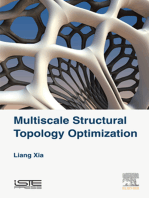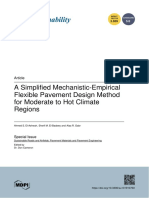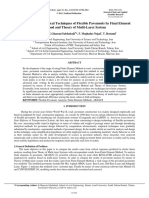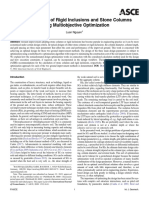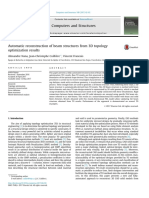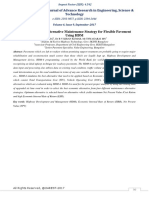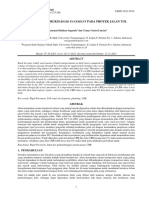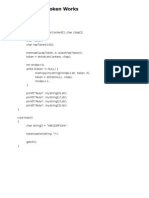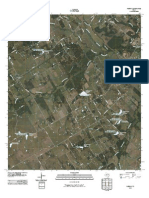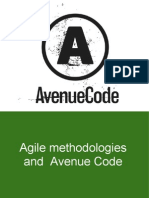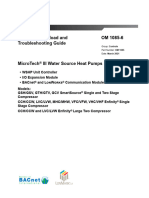Professional Documents
Culture Documents
Comparison Analysis of Flexible Pavement Thickness Between Indonesian PT T-01-2002-B and MDP 2017 Methods Using Finite Element Analysis
Comparison Analysis of Flexible Pavement Thickness Between Indonesian PT T-01-2002-B and MDP 2017 Methods Using Finite Element Analysis
Original Title
Copyright
Available Formats
Share this document
Did you find this document useful?
Is this content inappropriate?
Report this DocumentCopyright:
Available Formats
Comparison Analysis of Flexible Pavement Thickness Between Indonesian PT T-01-2002-B and MDP 2017 Methods Using Finite Element Analysis
Comparison Analysis of Flexible Pavement Thickness Between Indonesian PT T-01-2002-B and MDP 2017 Methods Using Finite Element Analysis
Copyright:
Available Formats
Volume 8, Issue 5, May 2023 International Journal of Innovative Science and Research Technology
ISSN No:-2456-2165
Comparison Analysis of Flexible Pavement Thickness
between Indonesian Pt T-01-2002-B and MDP 2017
Methods using Finite Element Analysis
Muhammad Yasin1*, Puguh Budi Prakoso2, Yasruddin3
1
Colleger, Postgraduate Civil Engineering 2,3 Lecturer, Postgraduate Civil Engineering,
Engineering Faculty, Lambung Mangkurat University
Banjarmasin, South Kalimantan, Indonesia
Abstract:- Indonesia has regulations and guidelines for In Indonesia, one of the methods used in designing
designing pavement structures modified by several pavement thickness is the Pt T-01-2002-B method which
developed countries. One of the pavement methods used originated from AASHTO 1993 and was modified according
in Indonesia is the Pt T-01-2002-B method derived from to the conditions of various factors in Indonesia. Along with
AASHTO 1993. However, today Indonesia has an update the times, Indonesia has an updated pavement design
on the pavement method used, namely the Pavement method that is currently used, namely the Manual Desain
Design Manual 2017 method sourced from AASHTO Perkerasan Jalan (MDP) 2017 method. This method is a
and AUSTROAD. The purpose of this study is to modification of AASHTO and AUSTROAD regulations.
determine the results of comparing the thickness of
Although there are updates to the pavement design
flexible pavement between the Pt T-01-2002-B and MDP
methods, these methods still have some disadvantages and
2017 methods by varying the CBR value and traffic load.
advantages so some of the old pavement guidelines are still
Then analyze the results of thick planning using Finite
used today. In the Pt T-01-2002-B method, some design
Element Analysis modeling in the ANSYS program
parameters do not have clear written reference parameters
which aims to determine the value of stress that occurs in
for designing pavement thickness. Meanwhile, MDP 2017
the subgrade. From the results of the research
has parameters that have been designed by the design chart
conducted, it was found that the variation of CBR value
[1].
> 1.5% overall pavement thickness produced using the
Pt T-01-2002-B method was thicker than MDP 2017 In the MDP 2017 guidelines [3] [4], the design of
method. However, at CBR 1.5%, the MDP 2017 method pavement thickness based on the ESA value of rank 4 should
produces a much thicker pavement than the Pt T-01- be used based on Pt T-01-2002-B guidelines [2]. In addition,
2002-B method. The large difference in pavement if subsurface drainage cannot be provided in the MDP 2017
thickness between the two methods is due to differences guidelines, the thickness of the aggregate foundation layer
in design parameters and the selection of pavement must be adjusted by using the drainage coefficient (m) value
materials. Based on the stress results, the Pt T-01-2002-B according to Pt T-01-2002-B. Then in a special case where
method is considered more conservative than the MDP there are many design variables and it is difficult to
2017 method. However, in soil conditions with CBR accommodate all of them using a design chart, the
values below 2.5%, the MDP 2017 method is considered reconstruction design solution for heavy traffic must be
more conservative. determined using the mechanistic design procedure, namely
the Pt T-01-2002-B method.
Keywords:- Flexible pavement; Pt T-01-2002-B; MDP
2017; odemark method; finite element analysis; stress. Based on the above, the old method can still be used to
provide a comparison of design results. Therefore, this
I. INTRODUCTION research will compare the design of flexible pavement
One way to be able to improve or build highway thickness between the Pt T-01-2002-B method and the MDP
construction, namely by planning or designing the thickness 2017 method which aims to provide a comparison of design
of the road flexible pavement by understanding and using results and find out which method is considered more
several methods. The correct use of the method will ensure conservative in pavement design.
the strength of the highway. Transportation is one of the
II. LITERATURE REVIEW
land transportation infrastructures that have an important
role in economic growth, socio-culture, tourism regional A. Finite Element Method
development, and defense and security to support national The principle of the Finite Element Method (Finite
development, so the importance of road pavement is Element Analysis) is to divide the problem domain, be it the
increasingly clear [6]. spatial domain or the time domain, into smaller subdomains
or elements. The core process of the Finite Element Method
is to divide a complex problem into smaller parts or
elements from which simpler solutions can be easily
derived. The solution of each element when combined will
be the overall problem solution [7]. The principle of this
method can be seen in Figure 1.
IJISRT23MAY813 www.ijisrt.com 846
Volume 8, Issue 5, May 2023 International Journal of Innovative Science and Research Technology
ISSN No:-2456-2165
E i ×(1-μ s 2 )
h eq = h i × 3
E s ×(1-μ i 2 )
Where: heq is equivalent thickness (mm), h i is
pavement thickness (mm), Ei is modulus elasticity of layer i
(MPa), µi is Poisson ratio of layer i, Es is modulus elasticity
of subgrade (MPa), µs is Poisson ratio of subgrade.
Fig. 1: Principle of finite element method
C. Heukelom & Klomp Equation
The number of equations to be solved is usually very The distributed stresses from the traffic load and
large, so obtaining a solution without using a computer is superstructure part should be reduced to the subgrade layer
almost impossible. Therefore, the use of computer software under the limit of its bearing capacity. The criteria in the
will be very useful in modeling FEA [11]. static design are mainly taken at the maximum stress or
strain at the soil's surface to guarantee a certain safe limit
One of the software that can make FEA modeling is against disproportionate plastic deformation and settlement
ANSYS. ANSYS is a software program that can model after cyclic loading during the service. According to Prakoso
finite elements to solve problems related to mechanics, (2017) [10] to calculate the allowable stress can use the
including static, dynamic, structural analysis (both linear and Heukelom & Klomp equation as follows.
nonlinear), heat transfer problems, fluid problems, and also
problems related to acoustics and electro magnetics [8]. 0.006 Edyn
allow
B. Odemark Method 1 0.7 log( N )
Odemark introduced a method, also known as the
Method of Equivalent Stiffness (MET), to transfer a multi- This equation suggests the allowable stress limit (σ allow)
layer system into a single-layer semi-half-space. This of the substructure layer considering only the material
method converts each layer with different materials into one dynamic modulus value (Edyn) and the number of load cycles
layer with the same material value as the subgrade. The (N).
principle of the Odemark method can be seen in Figure 2.
III. RESEARCH METHODS
In this study, a comparison of flexible pavement
thickness design between Pt T-01-2002-B and MDP 2017
methods will be conducted by varying the CBR value and
traffic load. The CBR value in this study is determined as
1.5%, 2.5%, 3%, 4%, 5%, 6%, 7%, 8%, 9%, 10%, 11%, and
12%. For traffic load values in this study, 1,000,000 ESAL,
5,000,000 ESAL, and 10,000,000 ESAL were determined.
From the results of the pavement thickness design, the
equivalent thickness can then be calculated using the
Odemark method for further analysis in FEA (Finite
Element Analysis) modeling in the ANSYS STUDENT
2022 R2 program which aims to determine the stress value
Fig. 2: Principle of odemark method equivalence theory on the subgrade. From the stress results, it will be known
whether the designed pavement thickness meets the
Based on Figure 2 to be able to calculate the stress in permissible stress using the Heukelom & Klomp equation.
such a two-layer system, Odemark's equivalence theory is Then the correlation relationship between the Pt T-01-2002-
helpful. The idea behind Odemark's theory is that the B and MDP 2017 methods can be made based on the results
vertical stress at the interface between the top layer with of the design thickness and stress values.
stiffness E1 and thickness h1 and the half-space with stiffness
Em is equal to the stress at the equivalent depth heq with IV. RESULTS AND DISCUSSION
stiffness Em. The figure on the left shows the vertical stress
distribution in a two-layer system. On the right side, the A. Comparison of Equivalent Thickness Results Between Pt
equivalent heq shows the same vertical stress result (B) at the T-01-2002-B and MDP 2017 Methods
Figure 3, Figure 4, and Figure 5 are the results of the
interface between the top layer and the half-space below [9].
comparison of equivalent pavement thickness between Pt T-
The use of this method has been proven in the research 01-2002-B and MDP 2017 methods at each traffic load
of Prakoso (2017) [10] which shows that by using the half- design. From these results, the graphs for traffic loads of
space system, the result of the stress that occurs in the soil 1,000,000 ESAL, 5,000,000 ESAL, and 10,000,000 ESAL
will be the same value when using a multi-layer system. all three show the same results where the smaller the CBR
Odemark's equation to calculate the equivalent thickness is value, the greater the need for pavement thickness and the
as follows: other way round. Then the soil with a good CBR value
IJISRT23MAY813 www.ijisrt.com 847
Volume 8, Issue 5, May 2023 International Journal of Innovative Science and Research Technology
ISSN No:-2456-2165
accompanied by an increase in traffic load does not have a The difference is because according to the MDP 2017
significant effect on the addition of pavement thickness. method design guidelines for soils with a CBR value < 6%
While the soil with a low CBR value, the increase in traffic require improvement of the subgrade or the addition of a
load will greatly affect the increase in pavement thickness. support layer that aims to have a bearing capacity equivalent
The three figures clearly show the difference in thickness to a CBR value of 6% or reach the minimum requirements.
between the two methods where the results of pavement Meanwhile, the Pt T-01-2002-B method itself has not set a
thickness for the Pt T-01-2002-B method as a whole look formula for improving the subgrade or adding a support
thicker than the MDP 2017 method. However, in the design layer. As for other parameters that affect the difference in
with a CBR value of 1.5%, there is a very significant pavement thickness in the two methods, among others, due
difference in pavement thickness between the two methods, to differences in the minimum thickness limits of the two
where instead the MDP 2017 method produces a much methods, besides that in the MDP 2017 method guidelines
thicker pavement than the Pt T-01-2002-B method. where the types of materials used such as modulus and
Poisson ratio values have been determined in the table, while
the Pt T-01-2002-B guidelines can design the type of
pavement material planned.
The results of the designed pavement thickness with a
CBR value ≥ 6% in both Pt T-01-2002-B and MDP 2017
methods do not show any significant changes in pavement
thickness. However, the increase in pavement thickness
begins to occur when the CBR value is below 6%. So it can
be said that 6% CBR is the CBR value needed to reach the
point where the pavement thickness meets the minimum
requirements.
Fig. 3: Comparison results of equivalent thickness at According to Eisenmann (2004) [5], the AASHTO
1,000,000 ESAL correlation equation between maintenance cost and
pavement quality is based on road construction testing where
the quality of the track geometry (Q g) and the stress at the
base of the track (Pz) can be expressed in a power function
relationship: Qg = (Pz)m. In which m can be of 3 to 4 power
degrees. Prakoso (2017) [10] also mentioned that the
increase in thickness at the SN value is due to the variation
of the repetition limit of the soil pressure and soil bearing
capacity which is close to the nonlinear power function.
Based on these two studies, the graphs of the equivalent
thickness correlation relationship between the Pt T-01-2002-
B and MDP 2017 methods depicted in Figure 6, Figure 7,
and Figure 8 show similar results where the shape of the
curve is similar to a power function. This indicates that the
Fig. 4: Comparison results of equivalent thickness at working system that occurs in soft soil conditions is neither
5,000,000 ESAL linear nor exponential but rather power which means that the
increase in value that occurs will be very significant, in this
case, the thickness of the pavement.
Fig. 5: Comparison results of equivalent thickness at
10,000,000 ESAL Fig. 6: Correlation of equivalent thickness at 1,000,000
ESAL
IJISRT23MAY813 www.ijisrt.com 848
Volume 8, Issue 5, May 2023 International Journal of Innovative Science and Research Technology
ISSN No:-2456-2165
Fig. 7: Correlation of equivalent thickness at 5,000,000 Fig. 9: FEA modeling output results in the ANSYS program
ESAL
Fig. 10: FEA modeling output results: Stress value on
Fig. 8: Correlation of equivalent thickness at 10,000,000
subgrade
ESAL
C. Comparison of Stress Values between Pt T-01-2002-B
The correlation of equivalent thickness obtained
and MDP 2017 Methods
between the Pt T-01-2002-B and MDP 2017 methods, which
Based on the output results of FEA modeling in the
are at a traffic load of 1,000,000 ESAL, the regression
ANSYS STUDENT 2022 R2 program, the stress values for
equation y = 0.0001x3 - 0.0453x2 + 6.8456x - 284.33 with a each pavement design method are obtained. In Figure 11,
coefficient of determination (R2) = 0.9971. At a traffic load Figure 12, and Figure 13, we can see the comparison graph
of 5,000,000 ESAL, the regression equation y = 7E-05x3 -
of stress values between the Pt T-01-2002-B and MDP 2017
0.0334x2 + 6.2307x - 293.68 with a coefficient of
methods.
determination (R2) = 0.9986. And at a traffic load of
10,000,000 ESAL, the regression equation y = 6E-05x3 -
0.0318x2 + 6.5348x - 340.87 with a coefficient of
determination (R2) = 0.9984.
B. FEA Modeling Results in ANSYS Program
Based on the results of the equivalent thickness in the Pt-
T-01-2002-B and MDP 2017 methods, further analysis is
carried out using the ANSYS STUDENT 2022 R2 program.
The data to be entered in the ANSYS program are modulus
of elasticity, Poisson ratio, and equivalent thickness. Where
the thickness analyzed is only one layer or a single layer.
The results will be obtained in the form of stress values that
occur in the subgrade. Figure 9 and Figure 10 are examples
of analysis results from FEA modeling for an equivalent
thickness is 416 cm with CBR data is 12%, subgrade Fig. 11: Comparison results of stress values at 1,000,000
modulus is 120 MPa, and Poisson ratio is 0.45. ESAL
IJISRT23MAY813 www.ijisrt.com 849
Volume 8, Issue 5, May 2023 International Journal of Innovative Science and Research Technology
ISSN No:-2456-2165
traffic load of 5,000,000 ESAL, the regression equation y =
1.655x - 8.215 with a coefficient of determination (R2) =
0.992. And at a traffic load of 10,000,000 ESAL, the
regression equation y = 1.748x - 8.946 with a coefficient of
determination (R2) = 0.961.
Fig. 12: Comparison results of stress values at 5,000,000
ESAL
Fig. 14: Correlation of stress values at 1,000,000 ESAL
Fig. 13: Comparison results of stress values at 10,000,000
ESAL
Fig. 15: Correlation of stress values at 5,000,000 ESAL
The graphs for traffic loads at 1,000,000 ESAL,
5,000,000 ESAL, and 10,000,000 ESAL all show the same
results where the higher the traffic load, the smaller the
stress that occurs on the subgrade. In addition, the greater
the CBR value, the higher the stress that tends to occur. It is
because the low CBR value requires a very thick pavement
layer so that the stress on the subgrade will be lower.
However, as the CBR value increases, the allowable stress
will also increase. It is shown from the three graphs above
that the stress results between the two design methods are
still below the allowable stress.
Overall, it is clear that the MDP 2017 method shows
greater stress values than the Pt T-01-2002-B method.
However, in the condition of CBR 1.5% or soft soil, the Pt
T-01-2002-B method shows higher stress results than the Fig. 16: Correlation of stress values at 10,000,000 ESAL
MDP 2017 method. Conversely, using the MDP 2017
method, the stress results for each variation of the traffic V. CONCLUSION
plan show lower values than the Pt T-01-2002-B method. So
it can be said that in soft soil conditions, the MDP 2017 The large difference in pavement thickness between Pt
method is more conservative than the Pt T-01-2002-B T-01-2002-B and MDP 2017 methods is due to differences
method. in design parameters and the selection of pavement
materials. The MDP 2017 guidelines for soils with a CBR
Figure 14, Figure 15, and Figure 16 show the value less than 6% require improvement of the subgrade or
correlation of stress values obtained between the Pt T-01- the addition of a support layer that aims to have a bearing
2002-B and MDP 2017 methods, which are at a traffic load capacity equivalent to a CBR value of 6% or reach the
of 1,000,000 ESAL, the regression equation y = 2.189x - minimum requirements, while the Pt T-01-2002-B method
15.29 with a coefficient of determination (R2) = 0.979. At a itself has not set a formula for improving the subgrade. Then
IJISRT23MAY813 www.ijisrt.com 850
Volume 8, Issue 5, May 2023 International Journal of Innovative Science and Research Technology
ISSN No:-2456-2165
in the MDP 2017 guidelines where the types of materials [7.] Isworo, Hajar. (2018). Metode Elemen Hingga.
used such as modulus values and Poisson ratio have been Penerbit Universitas Lambung Mangkurat.
determined in the table, while the Pt T-01-2002-B guidelines Banjarbaru.
can design the type of pavement material planned so that to [8.] Moaveni, Saeed. (1999). Finite Element Analysis:
find the efficiency of materials, the Pt T-01-2002-B Theory and Application with ANSYS. Penerbit
guidelines are suitable for use. Prentice-Hall. New Jersey.
[9.] Molenaar, A.A.A. (2009). Structural Design of
The correlation of equivalent thickness obtained Pavements Part III Design of Flexible Pavements.
between the Pt T-01-2002-B and MDP 2017 methods, which Handbook of Lecture, Faculty of Civil Engineering
are at a traffic load of 1,000,000 ESAL, y = 0.0001x3 - and Geosciences, TU Delft. Netherlands.
0.0453x2 + 6.8456x - 284.33 with R2 = 0.9971. At a traffic [10.] Prakoso, P. B. (2017). Analysis and Evaluation of
load of 5,000,000 ESAL, y = 7E-05x3 - 0.0334x2 + 6.2307x Railway Track Systems on Soft Soil: Trackbed
- 293.68 with R2 = 0.9986. And at a traffic load of Thickness Design and Dynamic Track-Soil
10,000,000 ESAL, y = 6E-05x3 - 0.0318x2 + 6.5348x - Interaction (Doctoral dissertation, Technische
340.87 with R2 = 0.9984. Universität München).
[11.] Prakoso, P. B. (2012). The Basic Concepts of
The correlation of stress values obtained between the Modelling Railway Track Systems using
Pt T-01-2002-B and MDP 2017 methods, which are at a Conventional and Finite Element Methods. INFO-
traffic load of 1,000,000 ESAL, y = 2.189x - 15.29 with R2 TEKNIK, 13(1), 57-65.
= 0.979. At a traffic load of 5,000,000 ESAL, y = 1.655x -
8.215 with R2 = 0.992. And at a traffic load of 10,000,000
ESAL, y = 1.748x - 8.946 with R2 = 0.961.
Based on the stress results obtained in both design
methods using FEA modeling, it can be concluded that
overall the design using the Pt T-01-2002-B method is
considered more conservative than MDP 2017 method.
However, in specific conditions where the soil with a CBR
value below 2.5%, the design using the MDP 2017 method
is considered more conservative than the Pt T-01-2002-B
method.
REFERENCES
[1.] Aris, M. N. A., Simbolon, G., Setiadji, B. H., &
Supriyono, S. (2016). Analisis Perbandingan
Perencanaan Tebal Perkerasan Jalan Lentur
Menggunakan Beberapa Metode Bina Marga Studi
Kasus: (Ruas Jalan Piringsurat – Batas Kedu Timur).
Jurnal Karya Teknik Sipil, 4(4), 380-393.
[2.] Departemen Pekerjaan Umum. (2002). Pedoman
Perencanaan Tebal Perkerasan Lentur Pt T-01-2002-
B. Penerbit Departemen Permukiman dan Prasarana
Wilayah. Jakarta.
[3.] Departemen Pekerjaan Umum. (2017). Manual
Desain Perkerasan Jalan No. 02/M/BM/2017.
Penerbit Kementerian Pekerjaan Umum dan
Perumahan Rakyat Direktorat Jenderal Bina Marga.
Jakarta.
[4.] Departemen Pekerjaan Umum. (2020). Suplemen
Manual Desain Perkerasan Jalan No. 01/S/MDP
2017. Penerbit Kementerian Pekerjaan Umum dan
Perumahan Rakyat Direktorat Jenderal Bina Marga.
Jakarta.
[5.] Eisenmann, J. (2004). Die Schiene als Tragbalken.
Eisenbahningenieur (55), 5/2004, p. 22-25.
[6.] Indriani, Made Novia. (2018). Metode-Metode
Perhitungan Perencanaan Tebal Perkerasan Lentur
Jalan. Penerbit SIGn. Makassar.
IJISRT23MAY813 www.ijisrt.com 851
You might also like
- J1939 Data Link TroubleshootingDocument18 pagesJ1939 Data Link TroubleshootingShanon BurgessNo ratings yet
- Pioneer Avh 3800dvd Avh 3850dvdDocument57 pagesPioneer Avh 3800dvd Avh 3850dvdnEtONo ratings yet
- Commissioning of Combined Heat and Power PlantsDocument27 pagesCommissioning of Combined Heat and Power PlantscmdcscribdNo ratings yet
- TRL615Document36 pagesTRL615Peyman MznNo ratings yet
- Continuous Improvement The BasicsDocument23 pagesContinuous Improvement The BasicsAdonis PajarilloNo ratings yet
- 361 677 1 PBDocument16 pages361 677 1 PBfachrizal ramadhanNo ratings yet
- GGGGG KKKDocument32 pagesGGGGG KKKaliNo ratings yet
- An ANSYS APDL Code For Topology Optimization of Structures With Multi-Constraints Using The BESO Method With Dynamic Evolution Rate (DER-BESO)Document26 pagesAn ANSYS APDL Code For Topology Optimization of Structures With Multi-Constraints Using The BESO Method With Dynamic Evolution Rate (DER-BESO)Jay SrivastavaNo ratings yet
- 2014 Lee and Madanat - Joint Optimization of Pavement Design, Resurfacing and Maintenance Strategies With History-Dependent Deterioration ModelsDocument13 pages2014 Lee and Madanat - Joint Optimization of Pavement Design, Resurfacing and Maintenance Strategies With History-Dependent Deterioration ModelsgongfutuNo ratings yet
- 1531 3998 1 SMDocument8 pages1531 3998 1 SMRizal Sopian SachlanNo ratings yet
- Evaluation of PavementsDocument16 pagesEvaluation of PavementsAVIWE KonzapiNo ratings yet
- A Simplified Mechanistic-Empirical Flexible Pavement Design Method For Moderate To Hot Climate RegionsDocument28 pagesA Simplified Mechanistic-Empirical Flexible Pavement Design Method For Moderate To Hot Climate RegionsMohammad NasimNo ratings yet
- 0000070Document28 pages0000070Ramesh JangalaNo ratings yet
- How To Select The Most Relevant Roughness ParameteDocument7 pagesHow To Select The Most Relevant Roughness ParametevinoNo ratings yet
- Tree-Based Ensemble Methods: Predicting Asphalt Mixture Dynamic Modulus For Flexible Pavement DesignDocument9 pagesTree-Based Ensemble Methods: Predicting Asphalt Mixture Dynamic Modulus For Flexible Pavement Designmohammad faresNo ratings yet
- Flexible Pavement Design LiteratureDocument8 pagesFlexible Pavement Design Literaturejignesh shahNo ratings yet
- EAC Micro Project 2-13Document30 pagesEAC Micro Project 2-13aditya.patil21212121No ratings yet
- State of The Art of Generative Design and Topology Optimization and Potential Research NeedsDocument15 pagesState of The Art of Generative Design and Topology Optimization and Potential Research NeedsMINHAJUL KABIRNo ratings yet
- Fmats 09 879245Document19 pagesFmats 09 879245CarloNo ratings yet
- Topology Optimization of Sheet Metal Brackets Using ANSYSDocument7 pagesTopology Optimization of Sheet Metal Brackets Using ANSYSMarcoNo ratings yet
- FEM in PavementDocument6 pagesFEM in PavementwesleynjNo ratings yet
- Comparacion Entre Metodos MEPDG 2022Document6 pagesComparacion Entre Metodos MEPDG 2022André BerninzonNo ratings yet
- Retaining Wall OptimizationDocument9 pagesRetaining Wall OptimizationMohamed EidNo ratings yet
- File 5 PDFDocument10 pagesFile 5 PDFAyesha AkhterNo ratings yet
- PDF - SolverDocument7 pagesPDF - SolverRAJKUMAR CHATTERJEE. (RAJA.)No ratings yet
- Application of Chaos Discrete Particle Swarm Optimization Algorithm On Pavement Maintenance Scheduling ProblemDocument11 pagesApplication of Chaos Discrete Particle Swarm Optimization Algorithm On Pavement Maintenance Scheduling ProblemAna Claudia BoettcherNo ratings yet
- IndexDocument28 pagesIndexMAS LiselotteNo ratings yet
- Asphalt Mix DesignDocument7 pagesAsphalt Mix DesignSafdar HasnainNo ratings yet
- Applied Sciences: Application of Finite Layer Method in Pavement Structural AnalysisDocument17 pagesApplied Sciences: Application of Finite Layer Method in Pavement Structural AnalysissdfsfNo ratings yet
- Image-Processing Techniques Applied To Road Problems: Journal of Transportation Engineering January 1992Document23 pagesImage-Processing Techniques Applied To Road Problems: Journal of Transportation Engineering January 1992azedNo ratings yet
- Ruiz - 2019 - Optimization of The Electromagnetic Scattering Problem Based On The TopologicalDocument20 pagesRuiz - 2019 - Optimization of The Electromagnetic Scattering Problem Based On The TopologicalDenis CarlosNo ratings yet
- Study On Analysis of Flexible Pavement Using Finite Element Based Software Tool IJERTV4IS090865Document5 pagesStudy On Analysis of Flexible Pavement Using Finite Element Based Software Tool IJERTV4IS090865pravin surveNo ratings yet
- A Review of Design and Construction paraDocument3 pagesA Review of Design and Construction parachengotom300No ratings yet
- 1065-Article Text-6555-4-10-20221104Document10 pages1065-Article Text-6555-4-10-20221104Mridul HasanNo ratings yet
- GMENG-7685 FinalfileDocument9 pagesGMENG-7685 FinalfileLuân NguyễnNo ratings yet
- Accuracy Comparison of Roadway Earthwork Computation Between 3D and 2D MethodsDocument9 pagesAccuracy Comparison of Roadway Earthwork Computation Between 3D and 2D Methodskrystal1911No ratings yet
- DownloadDocument13 pagesDownloadOlivia OeyNo ratings yet
- Fulltext01 PDFDocument138 pagesFulltext01 PDFBarham IbrahimNo ratings yet
- Finite Element Method in Geotechnical EngineeringDocument18 pagesFinite Element Method in Geotechnical EngineeringDaniel DalevineNo ratings yet
- Sustainability 13 10760 v2Document27 pagesSustainability 13 10760 v2Jobaer Al-MahmudNo ratings yet
- (2003) The Normalized Normal Constraint Method For Generation The Pareto FrontierDocument13 pages(2003) The Normalized Normal Constraint Method For Generation The Pareto FrontierJONATHAN JUSTINO APOS CASSIMIRONo ratings yet
- Automatic Reconstruction of Beam Structures From 3D Topology Optimization ResultsDocument21 pagesAutomatic Reconstruction of Beam Structures From 3D Topology Optimization ResultsWied Kukuh PrasetyoNo ratings yet
- Machines 09 00192 v2Document16 pagesMachines 09 00192 v2Mateusz RojewskiNo ratings yet
- Ranking of Bridge Design Alternatives: A Topsis-Fadr MethodDocument29 pagesRanking of Bridge Design Alternatives: A Topsis-Fadr MethodHieu BuiNo ratings yet
- Pavement Design ReserchDocument5 pagesPavement Design Reserchkhrizel lee tuazonNo ratings yet
- DokkenDocument25 pagesDokkenmichele baruccaNo ratings yet
- Timm 1998Document8 pagesTimm 1998gemmyNo ratings yet
- 3-Mir Iqbal Faheem-138Document11 pages3-Mir Iqbal Faheem-138Sachin RanaNo ratings yet
- Study On Different Alternative Maintenance Strategy For Flexible Pavement Using HDMDocument11 pagesStudy On Different Alternative Maintenance Strategy For Flexible Pavement Using HDMHardik SolankiNo ratings yet
- Analisis Perencanaan Tebal Perkerasan Lentur Dengan Metode Bina Marga (Studi Kasus: Jalan Luar Lingkar Timur Surabaya)Document10 pagesAnalisis Perencanaan Tebal Perkerasan Lentur Dengan Metode Bina Marga (Studi Kasus: Jalan Luar Lingkar Timur Surabaya)Saya AkuNo ratings yet
- 1 s2.0 S0141029623010726 MainDocument17 pages1 s2.0 S0141029623010726 MainHerliz CallirgosNo ratings yet
- Diaz Hasan Lu Icccbe18Document11 pagesDiaz Hasan Lu Icccbe18Shifat Hossain KhanNo ratings yet
- Metode Konstruksi Rigid Pavement Pada Proyek JalanDocument14 pagesMetode Konstruksi Rigid Pavement Pada Proyek JalanSyamsul AnwarNo ratings yet
- OptmizationTechniques Survey 2016Document12 pagesOptmizationTechniques Survey 2016Viviane FalcãoNo ratings yet
- Article Revision Report (AGD)Document18 pagesArticle Revision Report (AGD)FikeduNo ratings yet
- 17-CE-7 Assignment 01Document7 pages17-CE-7 Assignment 01Saad IlyasNo ratings yet
- Jurnaladm, 109-118 REV 03 325160117 - Verell RenggaDocument10 pagesJurnaladm, 109-118 REV 03 325160117 - Verell RenggaJanuarius LagoNo ratings yet
- Naskah Pubilkasi PDFDocument14 pagesNaskah Pubilkasi PDFedo tedaNo ratings yet
- Asphalt pavement maintenance plans intelligent decision model based on reinforcement learning algorithm-维护226144Document13 pagesAsphalt pavement maintenance plans intelligent decision model based on reinforcement learning algorithm-维护226144Yuan ChowNo ratings yet
- GIS-based Road Location in Sweden A Case Study ToDocument20 pagesGIS-based Road Location in Sweden A Case Study ToPedroNo ratings yet
- Jeas 1216 5448Document14 pagesJeas 1216 5448Andy YanNo ratings yet
- Salinan Perda Apbd MurniDocument8 pagesSalinan Perda Apbd MurniRacun BisaNo ratings yet
- Design and Development of Multi-Featured Medical StretcherDocument4 pagesDesign and Development of Multi-Featured Medical StretcherInternational Journal of Innovative Science and Research TechnologyNo ratings yet
- EmoConnect: Nurturing Trust and Relationship Bonds in Alzheimer’s ConversationsDocument3 pagesEmoConnect: Nurturing Trust and Relationship Bonds in Alzheimer’s ConversationsInternational Journal of Innovative Science and Research TechnologyNo ratings yet
- Smart and Secure Home with ChatbotDocument9 pagesSmart and Secure Home with ChatbotInternational Journal of Innovative Science and Research TechnologyNo ratings yet
- Skin Disease Detection and Remedial SystemDocument7 pagesSkin Disease Detection and Remedial SystemInternational Journal of Innovative Science and Research TechnologyNo ratings yet
- Unlocking Sentiments: Enhancing IOCL Petrol Pump ExperiencesDocument8 pagesUnlocking Sentiments: Enhancing IOCL Petrol Pump ExperiencesInternational Journal of Innovative Science and Research TechnologyNo ratings yet
- Development of Smart Ground Fault Location Model for Radial Distribution SystemDocument14 pagesDevelopment of Smart Ground Fault Location Model for Radial Distribution SystemInternational Journal of Innovative Science and Research TechnologyNo ratings yet
- Reading Intervention Through “Brigada Sa Pagbasa”: Viewpoint of Primary Grade TeachersDocument3 pagesReading Intervention Through “Brigada Sa Pagbasa”: Viewpoint of Primary Grade TeachersInternational Journal of Innovative Science and Research TechnologyNo ratings yet
- Preparation and Identification of Magnetic Iron Nanoparticle based on a Natural Hydrogel and its Performance in Targeted Drug DeliveryDocument17 pagesPreparation and Identification of Magnetic Iron Nanoparticle based on a Natural Hydrogel and its Performance in Targeted Drug DeliveryInternational Journal of Innovative Science and Research TechnologyNo ratings yet
- Application of Game Theory in Solving Urban Water Challenges in Ibadan-North Local Government Area, Oyo State, NigeriaDocument9 pagesApplication of Game Theory in Solving Urban Water Challenges in Ibadan-North Local Government Area, Oyo State, NigeriaInternational Journal of Innovative Science and Research TechnologyNo ratings yet
- On the Development of a Threat Driven Model for Campus NetworkDocument14 pagesOn the Development of a Threat Driven Model for Campus NetworkInternational Journal of Innovative Science and Research TechnologyNo ratings yet
- Esophageal Melanoma - A Rare NeoplasmDocument3 pagesEsophageal Melanoma - A Rare NeoplasmInternational Journal of Innovative Science and Research TechnologyNo ratings yet
- Application of Plant Growth Promoting Rhizobacteria on Vegetative Growth in Chili Plants (Capsicum frutescens L.)Document7 pagesApplication of Plant Growth Promoting Rhizobacteria on Vegetative Growth in Chili Plants (Capsicum frutescens L.)International Journal of Innovative Science and Research TechnologyNo ratings yet
- Global Warming Reduction Proposal AssessmentDocument6 pagesGlobal Warming Reduction Proposal AssessmentInternational Journal of Innovative Science and Research TechnologyNo ratings yet
- Firm Size as a Mediator between Inventory Management Andperformance of Nigerian CompaniesDocument8 pagesFirm Size as a Mediator between Inventory Management Andperformance of Nigerian CompaniesInternational Journal of Innovative Science and Research TechnologyNo ratings yet
- Exploring the Post-Annealing Influence on Stannous Oxide Thin Films via Chemical Bath Deposition Technique: Unveiling Structural, Optical, and Electrical DynamicsDocument7 pagesExploring the Post-Annealing Influence on Stannous Oxide Thin Films via Chemical Bath Deposition Technique: Unveiling Structural, Optical, and Electrical DynamicsInternational Journal of Innovative Science and Research TechnologyNo ratings yet
- PHREEQ C Modelling Tool Application to Determine the Effect of Anions on Speciation of Selected Metals in Water Systems within Kajiado North Constituency in KenyaDocument71 pagesPHREEQ C Modelling Tool Application to Determine the Effect of Anions on Speciation of Selected Metals in Water Systems within Kajiado North Constituency in KenyaInternational Journal of Innovative Science and Research TechnologyNo ratings yet
- Sustainable Energy Consumption Analysis through Data Driven InsightsDocument16 pagesSustainable Energy Consumption Analysis through Data Driven InsightsInternational Journal of Innovative Science and Research TechnologyNo ratings yet
- Mandibular Mass Revealing Vesicular Thyroid Carcinoma A Case ReportDocument5 pagesMandibular Mass Revealing Vesicular Thyroid Carcinoma A Case ReportInternational Journal of Innovative Science and Research TechnologyNo ratings yet
- A Study to Assess the Knowledge Regarding Teratogens Among the Husbands of Antenatal Mother Visiting Obstetrics and Gynecology OPD of Sharda Hospital, Greater Noida, UpDocument5 pagesA Study to Assess the Knowledge Regarding Teratogens Among the Husbands of Antenatal Mother Visiting Obstetrics and Gynecology OPD of Sharda Hospital, Greater Noida, UpInternational Journal of Innovative Science and Research TechnologyNo ratings yet
- Vertical Farming System Based on IoTDocument6 pagesVertical Farming System Based on IoTInternational Journal of Innovative Science and Research TechnologyNo ratings yet
- Detection of Phishing WebsitesDocument6 pagesDetection of Phishing WebsitesInternational Journal of Innovative Science and Research TechnologyNo ratings yet
- The Impact of Music on Orchid plants Growth in Polyhouse EnvironmentsDocument5 pagesThe Impact of Music on Orchid plants Growth in Polyhouse EnvironmentsInternational Journal of Innovative Science and Research Technology100% (1)
- Consistent Robust Analytical Approach for Outlier Detection in Multivariate Data using Isolation Forest and Local Outlier FactorDocument5 pagesConsistent Robust Analytical Approach for Outlier Detection in Multivariate Data using Isolation Forest and Local Outlier FactorInternational Journal of Innovative Science and Research TechnologyNo ratings yet
- Investigating Non-Newtonian Fluid Behavior in Hydrocyclones Via Computational Fluid DynamicsDocument18 pagesInvestigating Non-Newtonian Fluid Behavior in Hydrocyclones Via Computational Fluid DynamicsInternational Journal of Innovative Science and Research TechnologyNo ratings yet
- Osho Dynamic Meditation; Improved Stress Reduction in Farmer Determine by using Serum Cortisol and EEG (A Qualitative Study Review)Document8 pagesOsho Dynamic Meditation; Improved Stress Reduction in Farmer Determine by using Serum Cortisol and EEG (A Qualitative Study Review)International Journal of Innovative Science and Research TechnologyNo ratings yet
- Realigning Curriculum to Simplify the Challenges of Multi-Graded Teaching in Government Schools of KarnatakaDocument5 pagesRealigning Curriculum to Simplify the Challenges of Multi-Graded Teaching in Government Schools of KarnatakaInternational Journal of Innovative Science and Research TechnologyNo ratings yet
- Entrepreneurial Creative Thinking and Venture Performance: Reviewing the Influence of Psychomotor Education on the Profitability of Small and Medium Scale Firms in Port Harcourt MetropolisDocument10 pagesEntrepreneurial Creative Thinking and Venture Performance: Reviewing the Influence of Psychomotor Education on the Profitability of Small and Medium Scale Firms in Port Harcourt MetropolisInternational Journal of Innovative Science and Research TechnologyNo ratings yet
- Detection and Counting of Fake Currency & Genuine Currency Using Image ProcessingDocument6 pagesDetection and Counting of Fake Currency & Genuine Currency Using Image ProcessingInternational Journal of Innovative Science and Research Technology100% (9)
- Influence of Principals’ Promotion of Professional Development of Teachers on Learners’ Academic Performance in Kenya Certificate of Secondary Education in Kisii County, KenyaDocument13 pagesInfluence of Principals’ Promotion of Professional Development of Teachers on Learners’ Academic Performance in Kenya Certificate of Secondary Education in Kisii County, KenyaInternational Journal of Innovative Science and Research Technology100% (1)
- Review on Childhood Obesity: Discussing Effects of Gestational Age at Birth and Spotting Association of Postterm Birth with Childhood ObesityDocument10 pagesReview on Childhood Obesity: Discussing Effects of Gestational Age at Birth and Spotting Association of Postterm Birth with Childhood ObesityInternational Journal of Innovative Science and Research TechnologyNo ratings yet
- UoG-UCS-Handover Checklist V 1 0Document23 pagesUoG-UCS-Handover Checklist V 1 0Temesgen AyisheshimNo ratings yet
- Information Sciences: Gang Kou, Yi Peng, Guoxun WangDocument12 pagesInformation Sciences: Gang Kou, Yi Peng, Guoxun WangJorge Ivan Zapata RiverosNo ratings yet
- XML and Data Structre Sem B mt1Document88 pagesXML and Data Structre Sem B mt1sanju1tNo ratings yet
- User Manual - Garment ModuleDocument8 pagesUser Manual - Garment ModuleAredaNo ratings yet
- Flask-Sqlalchemy Documentation (2.X) : Release 2.4.4Document40 pagesFlask-Sqlalchemy Documentation (2.X) : Release 2.4.4Ryang SohnNo ratings yet
- CV Store Keeper MOHAMAAD AZHAR UDDIN PDFDocument4 pagesCV Store Keeper MOHAMAAD AZHAR UDDIN PDFMD AZHAR UDDINNo ratings yet
- How String WorksDocument13 pagesHow String WorksSagar Morje100% (1)
- 5G RAN and 5GC Network Slice Signaling - TechplayonDocument8 pages5G RAN and 5GC Network Slice Signaling - TechplayonMedAliAbdelliNo ratings yet
- Object Oriented Programming Lab 2Document14 pagesObject Oriented Programming Lab 2ali ahmedNo ratings yet
- iTECH PROJECT - JOB OPPORTUNITIESDocument6 pagesiTECH PROJECT - JOB OPPORTUNITIESKevinNo ratings yet
- 14 731e INFDocument1 page14 731e INFpabloNo ratings yet
- Booking Details - Departure: 13 June 2023 - GIG-QDUDocument5 pagesBooking Details - Departure: 13 June 2023 - GIG-QDUVictor LourençoNo ratings yet
- LP SensitivityAnalysisDocument47 pagesLP SensitivityAnalysisHarshit MishraNo ratings yet
- Topographic Map of PurdonDocument1 pageTopographic Map of PurdonHistoricalMapsNo ratings yet
- NR 220402 Electrical TechnologyDocument8 pagesNR 220402 Electrical TechnologySrinivasa Rao G100% (2)
- Reltio BasicsDocument8 pagesReltio Basicsrahul0% (1)
- Challenges That Handheld DevicesDocument11 pagesChallenges That Handheld DevicesMohamed Helmy SelimNo ratings yet
- Student6 IT640 IP5Document28 pagesStudent6 IT640 IP5SukthanaPongma100% (1)
- Simulation of Chromatographic Processes Using MATLAB: Bernt Nilsson, Per Borgqvist, Anders Axelsson and Guido ZacchiDocument4 pagesSimulation of Chromatographic Processes Using MATLAB: Bernt Nilsson, Per Borgqvist, Anders Axelsson and Guido Zacchiomkar khaladeNo ratings yet
- 0002 Sces ds02Document5 pages0002 Sces ds02thinh21No ratings yet
- Share GEC ELEC 1 REVIEWERDocument6 pagesShare GEC ELEC 1 REVIEWERAlyssa TalaveraNo ratings yet
- Red Hat Jboss Data Grid 7.2: Getting Started GuideDocument101 pagesRed Hat Jboss Data Grid 7.2: Getting Started Guidesomanath padhyNo ratings yet
- Sowbhagya 4.2 Years ETL Tester.Document5 pagesSowbhagya 4.2 Years ETL Tester.Sowbhagya VaderaNo ratings yet
- Avenue Code LectureDocument27 pagesAvenue Code LectureCintia Tiago GarciaNo ratings yet
- Microtech IIIDocument40 pagesMicrotech IIILê Anh TuấnNo ratings yet
- Automata Moore MealyMachineDocument6 pagesAutomata Moore MealyMachineratna.patilNo ratings yet


